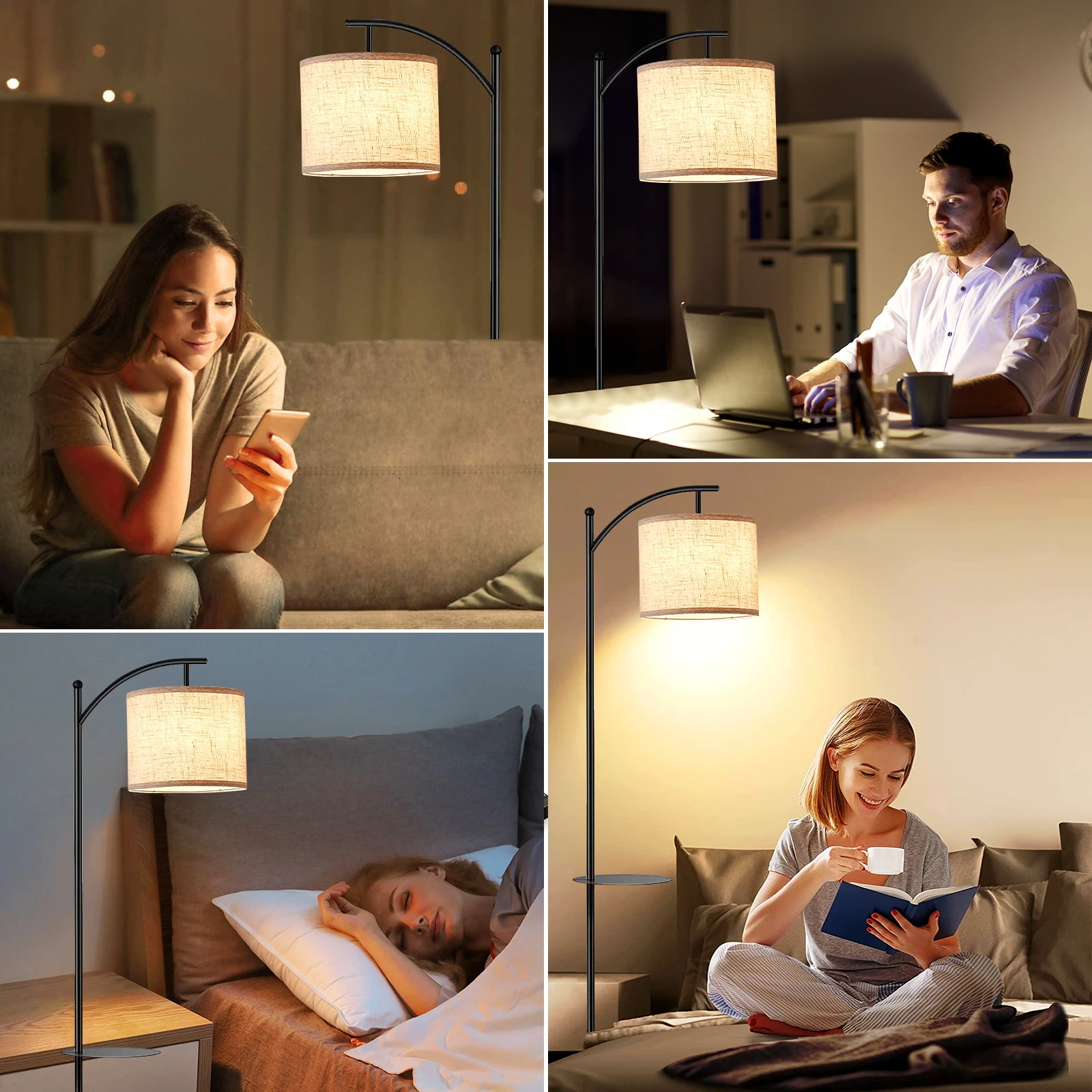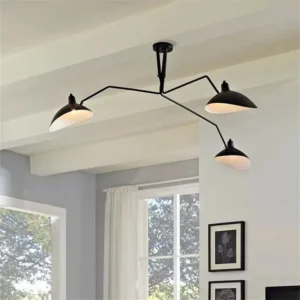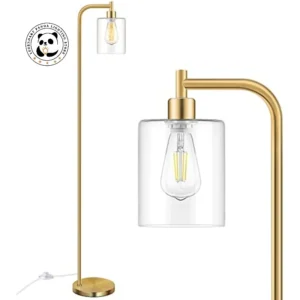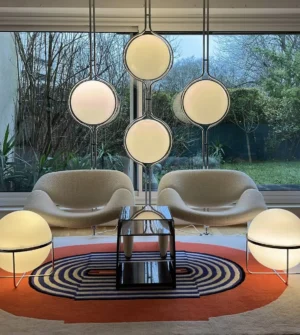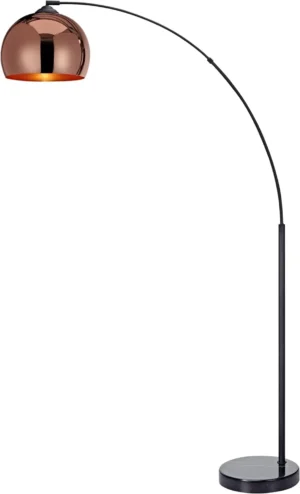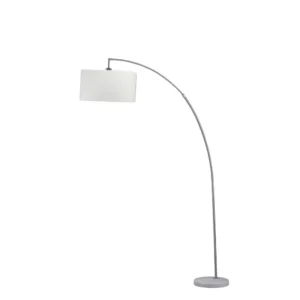Understanding Ambience Lighting: Setting the Perfect Mood
Ambience lighting is the art of using light to create a specific mood or atmosphere in a space. Unlike purely functional lighting that simply illuminates a room, ambient lighting is designed to evoke feelings and transform how we perceive and experience our surroundings.
The right lighting can dramatically change how we feel in a space. Soft, warm lighting tends to make us feel relaxed and comfortable, while brighter, cooler lighting can energize and stimulate. This isn’t just about preference—our brains are wired to respond to different types of light in specific ways, affecting everything from our mood to our sleep patterns.
What is Ambience Lighting?
Ambience lighting (sometimes called mood lighting) creates atmosphere through strategic light placement, intensity, and color temperature. It’s the foundation of interior lighting design that sets the emotional tone of a space.
The Danish concept of “hygge”—a feeling of cozy contentment—relies heavily on the soft, warm glow of properly designed lighting. Similarly, high-end hotels and restaurants invest significantly in lighting design to create memorable atmospheres that keep guests returning.
When considering your home’s lighting, think beyond mere functionality. The right dimmable lighting can transform your space in remarkable ways, turning an ordinary room into a sanctuary that reflects and enhances your desired mood. Many interior designers consider lighting to be the single most important element in setting a room’s ambience.
The psychological impact of lighting can’t be overstated. Studies show that lighting affects everything from our perception of spaciousness to our emotional well-being. By understanding how different lighting choices influence mood, you can create spaces that support relaxation, productivity, or socialization based on your needs. Arc floor lamps contribute significantly to mood lighting by providing both directed and ambient illumination.
The Three Essential Layers of Lighting Design
Creating truly effective ambience requires understanding the layered approach to lighting design. Professional interior designers typically work with three distinct layers that, when combined thoughtfully, create spaces with depth, function, and mood.
Ambient (General) Lighting:
– Serves as the foundation layer that provides overall illumination
– Replaces natural light and ensures basic visibility throughout the space
– Usually comes from ceiling-mounted fixtures, recessed lights, or wall-mounted lights
– Ideally provides even illumination without harsh shadows or overly bright spots
– Should be bright enough for safety but not so bright that it feels clinical
Task Lighting:
– Provides focused illumination for specific activities
– Examples include reading lamps, under-cabinet kitchen lighting, and desk lamps
– Should be bright enough to prevent eye strain but positioned to avoid glare
– Often needs to be adjustable to accommodate different tasks and users
– Generally requires 2-3 times the illumination of ambient lighting
Accent Lighting:
– Adds drama, creates visual interest, and highlights architectural features or décor
– Includes wall washers, picture lights, uplighting, and directional spotlights
– Creates depth by introducing contrast between lit and unlit areas
– Often uses 3-5 times the illumination of ambient light to effectively highlight objects
– Can completely transform the feel of a space by drawing attention to specific elements
The 60-30-10 rule serves as a helpful guideline: approximately 60% of a room’s light should come from ambient sources, 30% from task lighting, and 10% from accent lighting. This balanced distribution creates layered, nuanced lighting that feels natural and supports various activities.
Achieving perfect ambience often requires multi-light fixtures that can serve multiple lighting layers. For example, an arc floor lamp with multiple adjustable heads can provide both task lighting for reading and accent lighting to highlight artwork, all while contributing to the room’s ambient glow.
Understanding these fundamental layers is essential before selecting specific fixtures. Each type of light serves a distinct purpose, and mastering ambient lighting techniques with arc lamps allows you to create spaces that are both functional and emotionally resonant.
Color Temperature: Finding Your Perfect Warmth
Color temperature fundamentally shapes how we perceive a space. Measured on the Kelvin (K) scale, this technical aspect of lighting directly influences the mood and feel of your home.
Lower Kelvin values produce “warmer” light with yellowish, amber, or reddish tones, while higher values create “cooler” light with bluish tones. This seemingly technical measurement has profound effects on how comfortable, relaxing, or energizing a space feels.
| Kelvin Range | Light Appearance | Best For | Mood Effect |
|---|---|---|---|
| 1800K-2200K | Very warm (candlelight) | Intimate dining, relaxation nooks | Extremely cozy, romantic |
| 2200K-2700K | Warm white (traditional incandescent) | Living rooms, bedrooms | Relaxed, comfortable |
| 2700K-3000K | Soft white | Versatile use, living spaces | Welcoming, pleasant |
| 3000K-3500K | Neutral white | Kitchens, workspaces | Balanced, natural |
| 3500K-4000K | Cool white | Offices, task-focused areas | Alert, clean |
| 4000K-6500K | Daylight | Art studios, detailed tasks | Energizing, stimulating |
For creating ambience in most home settings, lights in the 2200K-3000K range generally work best. This warm range mimics the golden hour of sunset, creating a naturally comforting environment that helps people relax and feel at ease. Research has shown that exposure to warmer light in evening hours also supports better sleep patterns by not interfering with melatonin production.
Seasonal considerations also matter. In winter months, warmer lighting (around 2700K) can create a cozy contrast to the cold outside, while summer might benefit from slightly cooler temperatures (around 3000K) for a refreshing feel.
Dimmable lamps provide control over light intensity, but color temperature is equally important. Many modern arc lamps include features for controlling color temperature, allowing you to adjust both brightness and warmth to match your mood or the time of day.
When selecting lighting for ambience, color temperature should be your first consideration. The most beautiful fixture with the wrong color temperature will fail to create the atmosphere you desire, while even simple fixtures with the right temperature can transform your space.

Mastering Light Intensity for Perfect Ambience
Understanding and controlling light intensity is crucial for creating the perfect ambience. While color temperature affects the quality of light, intensity determines how much light fills your space—directly impacting mood and functionality.
Light intensity is measured in lumens, which indicates brightness, rather than watts, which measures energy consumption. This distinction matters because different bulb technologies (LED, incandescent) produce different amounts of light using the same energy. For ambient lighting:
- Living rooms typically need 1,500-3,000 lumens of ambient light (combined from all sources)
- Dining rooms benefit from 3,000-6,000 lumens, concentrated over the table
- Bedrooms function well with 1,000-2,000 lumens for ambient lighting
- Bathrooms require 4,000-8,000 lumens for adequate brightness
Dimmability is perhaps the single most important feature for achieving perfect ambience. Rooms serve multiple purposes throughout the day, and your lighting should adapt accordingly. A living room might need bright light for cleaning but soft illumination for evening relaxation.
Modern dimming options include:
- Traditional wall dimmers that replace standard switches
- Smart dimmers that can be controlled via apps or voice assistants
- Integrated dimmers built directly into lamp bases
- Step dimmers with preset brightness levels
When selecting fixtures for ambience, consider whether they offer appropriate dimming capabilities. Many LED options provide controlled light intensity with smooth dimming from 100% down to 5% or lower, without the flickering often associated with older dimming technology.
The benefits of adjustable brightness features extend beyond mood setting—they also help reduce energy consumption and extend bulb life. Additionally, properly dimmed lighting creates layers of brightness throughout a room, adding depth and visual interest that flat, uniform lighting lacks.
For truly effective ambient lighting, combine different intensities within the same space. For example, a moderately bright arc floor lamp might provide ambient illumination while a dimmer table lamp creates an intimate zone for conversation or reading. This layered approach creates visual hierarchy and guides the eye through the space.
Floor Lamps: The Versatile Ambience Creators
Floor lamps stand among the most versatile tools for creating ambience, offering flexibility that few other lighting solutions can match. Unlike fixed ceiling fixtures or recessed lighting, floor lamps can be repositioned as needed, allowing you to experiment with different lighting arrangements until you achieve your desired atmosphere.
Arc floor lamps deserve special attention for their unique ability to create dramatic ambient lighting. Their distinctive curved design allows the light source to be positioned directly over seating areas, dining tables, or other focal points while keeping the base tucked away. This creates a floating light effect that adds architectural interest while providing practical illumination.
The direction of light from floor lamps significantly affects ambience:
- Uplighting: Directing light toward the ceiling creates soft, diffused illumination that fills the room without harsh shadows or glare. This technique makes spaces feel larger and more open.
- Downlighting: Aiming light downward creates focused pools of illumination, perfect for reading nooks or highlighting specific areas. This creates intimate zones within larger spaces.
- Diffused lighting: Lamp shades that emit light in all directions create a gentle glow that softens the entire room.
Strategic placement amplifies a floor lamp’s impact on ambience:
- Position arc lamps to curve over seating areas, creating a natural gathering point
- Place floor lamps in dark corners to eliminate shadows and balance overall room lighting
- Use pairs of matching floor lamps to frame architectural features or large furniture pieces
- Consider height—taller lamps (over 60 inches) create more dramatic lighting effects
Shade materials dramatically influence the quality of light:
– Opaque metal shades direct light precisely where needed
– Fabric shades diffuse light, creating a softer glow
– Glass shades can either diffuse or direct light depending on their transparency
– Perforated shades create interesting shadow patterns on walls and ceilings
Wood arc floor lamps add natural warmth through both their material and the quality of light they emit. The organic elements bring a grounding quality to modern spaces while creating ambiance through their dimmable features.
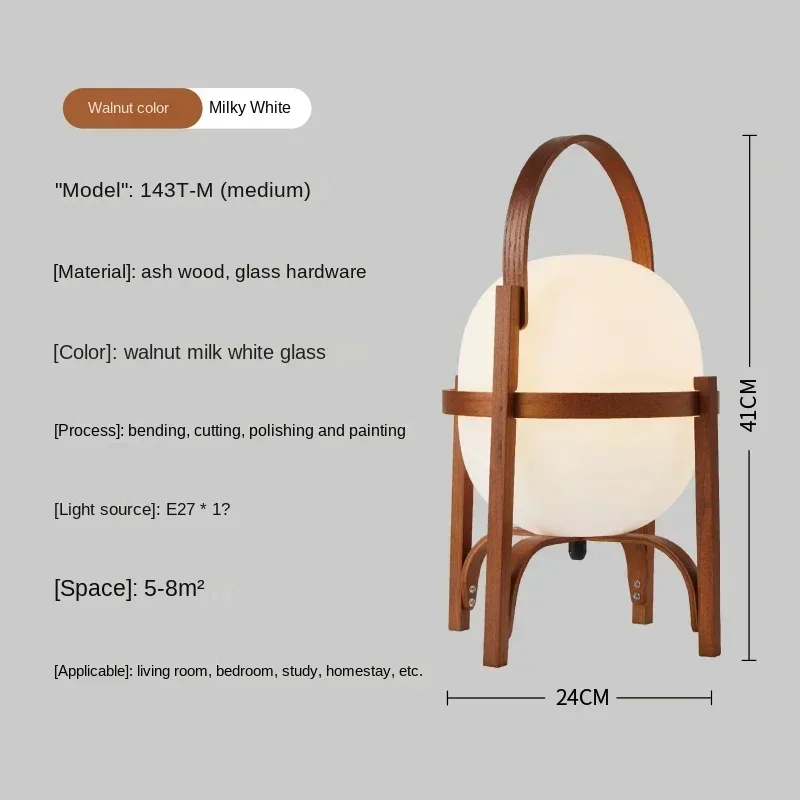
Table Lamps and Sconces: Creating Intimate Lighting Zones
While floor lamps excel at providing dramatic lighting statements, table lamps and wall sconces create those essential intimate lighting zones that make a house feel like a home. These smaller fixtures create pools of light that draw people together and define functional areas within larger spaces.
Table lamps create natural gathering points and conversation areas. Their lower height means the light they cast is concentrated rather than dispersed, creating a distinct boundary between illuminated and dimmer areas. This natural boundary helps define intimate zones within open-concept spaces.
For maximum ambience with table lamps:
– Place pairs on either side of a sofa or bed to create balanced illumination
– Use smaller lamps with opaque shades on side tables to create concentrated pools of light
– Select larger lamps with translucent shades in areas where more diffused light is desired
– Consider the lamp base as a design element—metallic bases reflect light while dark bases absorb it
Wall sconces add dimension by bringing light directly to vertical surfaces. Unlike overhead lighting that flattens a space, sconces create dramatic shadows and highlights that emphasize texture and architectural details. They’re particularly effective for:
– Framing mirrors and artwork
– Illuminating hallways without consuming floor space
– Creating rhythm along longer walls
– Adding ambient light without cluttering surfaces
The shape of a lamp shade significantly impacts light distribution:
– Drum shades provide even, diffused light in all directions
– Empire shades direct more light downward for focused illumination
– Bell shapes balance downward and outward light
– Rectangular shades cast dramatic directional light
When planning intimate lighting zones, consider how different fixtures will work together. The strategic placement of floor and table lamps should create overlapping layers of light rather than isolated bright spots. This thoughtful positioning creates a cohesive lighting scheme that guides movement through the space while maintaining distinct areas for different activities.
- Price range: $174.28 through $658.31 Select options This product has multiple variants. The options may be chosen on the product page
Brass Arc Floor Lamp, Contemporary Arc Floor Lamp, LED Arc Floor Lamp
Price range: $490.72 through $522.04 Select options This product has multiple variants. The options may be chosen on the product pageChrome Arc Floor Lamp, LED Arc Floor Lamp
Price range: $304.95 through $1,210.40 Select options This product has multiple variants. The options may be chosen on the product pageContemporary Arc Floor Lamp, Large Arc Floor Lamp, Marble Base Arc Floor Lamp
$224.94 Select options This product has multiple variants. The options may be chosen on the product pageMid-Century Arc Floor Lamp, Wood Arc Floor Lamp
$230.86 Select options This product has multiple variants. The options may be chosen on the product pageContemporary Arc Floor Lamp, Silver Arc Floor Lamp
$459.99 Select options This product has multiple variants. The options may be chosen on the product page
Overhead Lighting: Beyond Basic Illumination
Overhead lighting often gets a bad reputation when it comes to creating ambience, dismissed as too harsh or utilitarian. However, with the right approach, ceiling fixtures can contribute significantly to a room’s atmosphere while providing necessary illumination.
The secret to successful overhead ambient lighting is control—specifically, dimming capability and thoughtful fixture selection. A dimmable overhead light instantly transforms from practical task lighting to gentle ambient illumination with the slide of a switch. This flexibility allows a single fixture to serve multiple purposes throughout the day.
Different overhead fixtures create distinctly different ambient effects:
Chandeliers: Beyond their decorative impact, chandeliers create complex shadow patterns and light dispersion. Crystal elements refract light, creating sparkle and movement, while fabric shades soften and diffuse illumination.
Pendant Lights: Hanging at different heights, pendants can create visual rhythm and define zones within an open space. Clustered pendants create a dramatic focal point, while evenly spaced pendants provide consistent illumination.
Recessed Lighting: Often overlooked for ambience, properly selected recessed lights with warm-toned bulbs, wall-washing trim, or adjustable eyeball fixtures can highlight architectural features and artwork while contributing to the overall light level.
Diffusion techniques significantly improve the ambient quality of overhead lighting:
– Frosted glass shades soften light and eliminate harsh shadows
– Fabric diffusers warm the light and reduce glare
– Perforated metal shades create patterned light effects
– Upward-facing bowls bounce light off the ceiling for the gentlest illumination
Ceiling height should directly influence your overhead lighting choices. In spaces with high ceilings, specialized lighting solutions like extended-stem pendants or multi-tier chandeliers help bring light down to human scale, creating cozier environments despite the volume of the room.
For optimal ambience, overhead lighting should work in concert with other light sources rather than dominating the space. By keeping overhead fixtures on separate switches or dimmers from floor and table lamps, you can adjust the balance of light sources as needed throughout the day and evening.
Creative Ambient Light Sources: Beyond Traditional Fixtures
While traditional lamps and fixtures form the backbone of most lighting plans, thinking beyond conventional options opens up extraordinary possibilities for creating unique ambience. These creative lighting solutions can transform ordinary spaces into captivating environments with relatively modest investments.
LED strip lighting has revolutionized ambient lighting by making it possible to add illumination to previously impractical locations:
– Under kitchen and bathroom cabinets to eliminate harsh shadows
– Along the underside of beds for a floating effect and subtle nighttime illumination
– Behind TVs or artwork to create a halo effect that reduces eye strain and adds depth
– Along stair treads or baseboards for safety and dramatic effect
– Under furniture pieces like sofas and consoles for a floating appearance
Illuminated panels and backlit elements add both light and artistic interest:
– Backlit headboards transform bedroom ambience
– Edge-lit glass shelving makes displayed items appear to float
– Translucent stone panels with backing illumination create dramatic feature walls
– Light boxes with interchangeable art offer versatile mood lighting
String lights and fairy lights have transcended their seasonal associations to become year-round ambient lighting options:
– Woven through bookshelves to highlight collections
– Clustered in glass containers as luminous sculptures
– Draped across ceiling beams for a starry effect
– Wrapped around indoor plants to create magical garden effects
Candles remain unmatched for creating authentic warmth and movement in light:
– Grouped at varying heights for dynamic compositions
– Placed in front of mirrors to multiply their effect
– Used with hurricane lanterns for outdoor spaces
– Supplemented with flameless LED alternatives for safety and convenience
Projection and pattern lighting creates dynamic environments:
– Moon lamps that cast realistic lunar patterns
– Water ripple projectors for relaxing, meditative effects
– Adjustable pattern projectors that cast leaf shadows or geometric designs
– Smart projectors that can change patterns based on music or time of day
Contemporary arc floor lamps frequently incorporate these creative lighting elements, combining traditional form with modern technology for stunning visual effects. The best ambient lighting often emerges from combining conventional fixtures with these more innovative approaches, creating layers of light that can be adjusted for different moods and occasions.
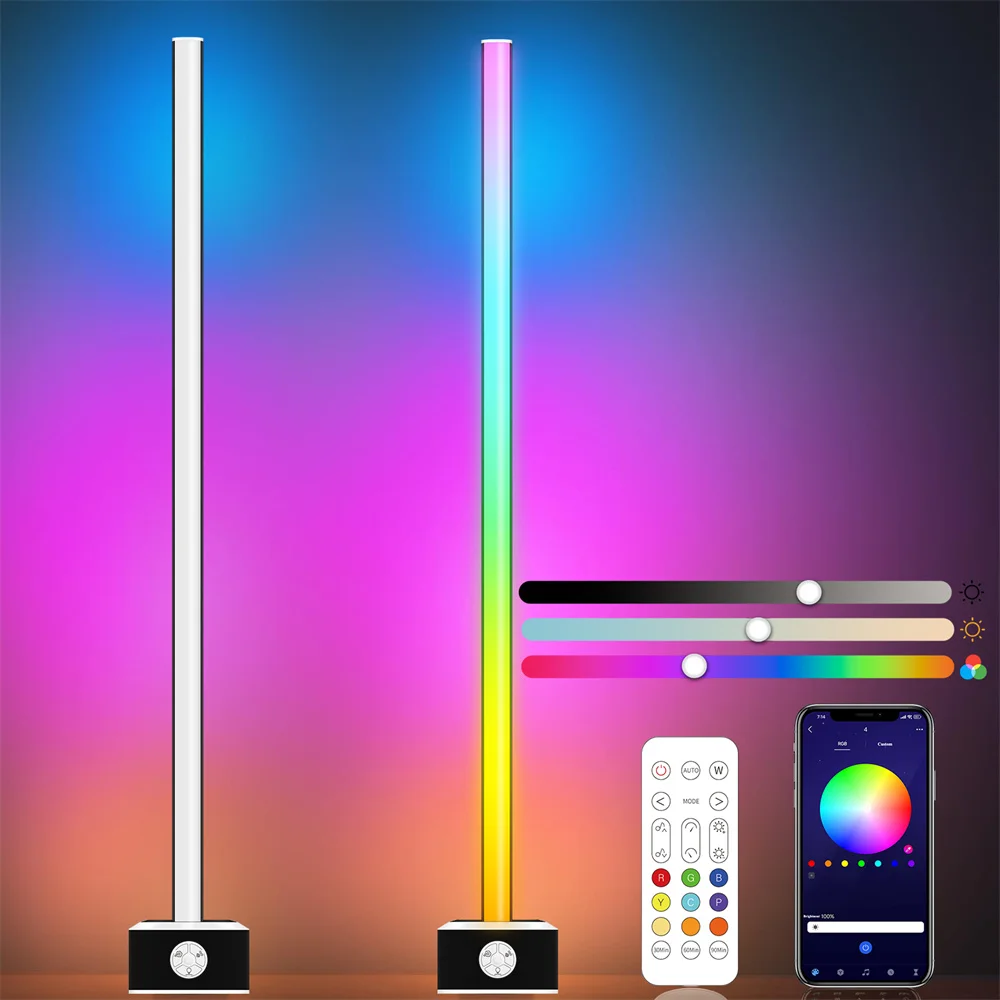
Room-by-Room Ambience Lighting Guide
Each room serves different functions and creates different emotional needs, requiring tailored approaches to ambient lighting. This guide will help you select the right combination of lighting elements for each space in your home.
Living Room
– Primary Goal: Versatile lighting for conversation, relaxation, and entertainment
– Recommended Fixtures: Arc floor lamp over seating areas, table lamps on side tables, dimmable overhead lighting, wall sconces flanking focal points
– Ambience Tips: Create at least three distinct light sources at different heights; ensure all lights can be controlled independently; position lighting to highlight architectural features
– Color Temperature: 2700K-3000K for warm, inviting atmosphere
Bedroom
– Primary Goal: Relaxing, restful environment with practical task lighting for reading
– Recommended Fixtures: Bedside table lamps or wall sconces, gentle overhead lighting, optional floor lamp in reading corner
– Ambience Tips: All lights should be dimmable; avoid harsh downlighting directly over the bed; consider under-bed LED strips for nighttime navigation
– Color Temperature: 2400K-2700K for the most relaxing environment
Dining Room
– Primary Goal: Flattering, intimate lighting that enhances food presentation
– Recommended Fixtures: Statement pendant or chandelier positioned over table, supplementary buffet lamps or sconces, optional recessed perimeter lighting
– Ambience Tips: Hang central fixture 30-36 inches above table; ensure dimming capability; avoid downlights that cast unflattering shadows on faces
– Color Temperature: 2700K-3000K to enhance food colors and create warmth
Kitchen
– Primary Goal: Functional lighting that can transition to atmospheric when entertaining
– Recommended Fixtures: Under-cabinet lighting, pendant lights over islands, dimmable recessed lighting
– Ambience Tips: Create separate zones for prep areas and dining spaces; use separate switches for task and ambient lighting; consider toe-kick lighting for nighttime navigation
– Color Temperature: 3000K-3500K for task areas, 2700K for dining areas
Bathroom
– Primary Goal: Functional lighting for grooming with option for spa-like relaxation
– Recommended Fixtures: Sconces or vertical fixtures flanking mirrors, overhead lighting, optional recessed shower light
– Ambience Tips: All lighting should be on separate switches; consider LED strips under vanities; install dimmer for relaxing bath time
– Color Temperature: 3000K-3500K near mirrors for accurate grooming, 2700K for ambient light
Home Office
– Primary Goal: Adequate task lighting that minimizes eye strain while maintaining comfort
– Recommended Fixtures: Adjustable desk lamp, ambient floor lamp, natural light supplements
– Ambience Tips: Position light sources to minimize screen glare; ensure light comes from slightly above eye level; consider light therapy lamps for windowless offices
– Color Temperature: 3500K-4000K during working hours, dimmable warmer options for evening use
Black arc floor lamps work particularly well across multiple room settings due to their neutral finish and versatile design. When choosing the perfect dimmable arc lamp for each room, consider both the functional requirements and the emotional atmosphere you wish to create.
Smart Lighting: The Future of Ambience Control
Smart lighting systems have revolutionized how we create and control ambience, offering unprecedented flexibility and convenience. These technologies transform ordinary spaces into responsive environments that adapt to our needs and moods throughout the day.
The foundation of smart ambient lighting lies in two main components:
– Smart bulbs: Individual light bulbs with built-in wireless connectivity that can be controlled remotely
– Smart switches/plugs: Devices that control conventional lighting fixtures, adding smart functionality to existing lamps
The advantages of smart lighting for ambience creation include:
– Precise dimming control from 1-100% (rather than limited presets)
– Color temperature adjustment throughout the day to match natural light cycles
– Full-spectrum color changing for dramatic effects or subtle mood enhancement
– Voice control through assistants like Alexa, Google Assistant, or Siri
– Programmable scenes that adjust multiple lights simultaneously
– Scheduling that automatically transitions lighting throughout the day
– Vacation modes that mimic occupancy for security
– Integration with motion sensors, door sensors, and other smart home devices
Creating effective ambience with smart lighting involves setting up scenes for different activities and moods:
– “Movie Night” scene that dims overheads while leaving subtle accent lighting
– “Dinner Party” scene that creates warm lighting over the table while illuminating food preparation areas
– “Relaxation” scene with warm, low lighting in living areas
– “Morning Routine” scene that gradually increases brightness and shifts to energizing cooler tones
More advanced smart lighting systems offer circadian rhythm programming, which automatically adjusts color temperature throughout the day to support natural sleep-wake cycles. These systems start with energizing cooler light in the morning, transition to neutral midday light, and gradually shift to warmer, dimmer light in evening hours.
The ultimate guide to adjustable lighting explores these smart options in greater detail, providing insights into creating dynamic lighting environments that respond to both scheduled programming and spontaneous needs.
For those new to smart lighting, starting with a few key fixtures in main living areas allows you to experience the benefits before committing to a whole-home system. Many homeowners begin with smart table or floor lamps in living rooms before expanding to other spaces.
Common Ambient Lighting Mistakes to Avoid
Even with the best fixtures and bulbs, certain common mistakes can undermine your efforts to create perfect ambience. Being aware of these pitfalls helps ensure your lighting enhances rather than detracts from your space.
Relying solely on overhead lighting
Single-source overhead lighting creates harsh shadows, flattens textures, and generally feels institutional rather than inviting. Solution: Add floor lamps, table lamps, and wall sconces to create multiple light sources at different heights.Choosing the wrong color temperature
Cool white bulbs (4000K+) in living spaces create a clinical, unwelcoming atmosphere, while very warm bulbs can make some spaces feel dated or dim. Solution: Stick with 2700K-3000K for living spaces, reserving cooler temperatures for workspaces and bathrooms.Ignoring the importance of dimmers
Fixed-brightness lights cannot adapt to changing conditions or needs throughout the day. Solution: Install dimmers for all overhead fixtures and choose dimmable options for lamps.Installing recessed lights in a rigid grid pattern
Evenly spaced recessed lights create flat, uninspired illumination without visual interest. Solution: Position recessed lights to highlight architectural features, artwork, or task areas rather than in a symmetrical grid.Forgetting about natural light interaction
Artificial lighting schemes that don’t account for changing daylight conditions waste energy and miss opportunities for beautiful blended light. Solution: Consider how natural light moves through your space when positioning fixtures, and use light-sensitive controls where appropriate.Creating hot spots and glare
Exposed bulbs and poorly positioned fixtures can create uncomfortable glare and visual hot spots. Solution: Use shades, diffusers, and thoughtful positioning to ensure light is evenly distributed.Under-lighting or over-lighting spaces
Too little light creates strain and feels unwelcoming, while too much light feels harsh and wastes energy. Solution: Follow recommended lumens-per-square-foot guidelines for each room type.Neglecting shadows and contrast
Completely eliminating shadows creates flat, uninteresting spaces without depth. Solution: Strategically use shadows to create visual interest and highlight textures.Forgetting about reflective surfaces
Mirrors, glossy furniture, and metallic accents all interact with light sources, sometimes creating unwanted glare. Solution: Test lighting with all furnishings in place and adjust as needed.Installing fixtures at incorrect heights
Pendants hung too high or too low, wall sconces at uncomfortable viewing angles, or table lamps of improper height can all disrupt ambience. Solution: Follow standard height guidelines while accounting for your specific furniture and ceiling height.
How to Choose Light Bulbs for Perfect Ambience
The light bulb you select has as much impact on ambience as the fixture itself. Understanding bulb characteristics helps you make choices that create the exact mood you desire.
Bulb Technology Comparison:
| Feature | LED | Incandescent | Halogen |
|---|---|---|---|
| Ambience Quality | Excellent (with high CRI) | Excellent | Very Good |
| Energy Efficiency | Highest | Lowest | Moderate |
| Lifespan | 15,000-25,000 hours | 750-2,000 hours | 2,000-4,000 hours |
| Dimmability | Good (with compatible dimmers) | Excellent | Very Good |
| Color Temperature Range | Widest (2200K-6500K) | Limited (2700K-3000K) | Moderate (2800K-3200K) |
| Cost | Higher upfront, lowest long-term | Lowest upfront, highest long-term | Moderate |
Color Rendering Index (CRI) measures how accurately a light source displays colors compared to natural light. For ambient lighting, choose bulbs with CRI of 90+ for the most natural and flattering light quality. Lower CRI bulbs (below 80) can make colors appear flat or distorted, undermining your interior design efforts.
LED bulbs have revolutionized ambient lighting by offering excellent energy efficiency without compromising light quality. When selecting LEDs:
– Look for “warm dim” LEDs that mimic the color shift of incandescent bulbs when dimmed
– Choose “flicker-free” models for the most comfortable lighting experience
– Consider “filament” or “vintage” LEDs for exposed bulb fixtures
– Select appropriate beam angles (narrow for highlighting, wide for general illumination)
Decorative bulbs add visual interest when visible in open fixtures:
– Edison-style bulbs create nostalgic warmth with their visible filaments
– Globe bulbs provide omnidirectional light with a modern aesthetic
– Tubular bulbs create dramatic linear lighting effects
– Candelabra bulbs add elegance to traditional chandeliers and sconces
Beyond technical specifications, consider how different bulbs create different moods:
– Soft white bulbs (2700K-3000K) create cozy, welcoming environments
– Bright white bulbs (3500K-4100K) create alert, clean environments
– Daylight bulbs (5000K-6500K) create energizing, task-oriented environments
For the most flexible ambience options, consider investing in smart bulbs that allow you to change color temperature and brightness on demand, adapting to different needs and moods throughout the day.
Does Natural Light Affect Ambient Lighting Design?
Natural light is the original ambient light source and should be considered the foundation of your lighting design. The interaction between natural and artificial light dramatically influences how a space feels throughout the day and across seasons.
The orientation of your rooms determines the quality and quantity of natural light you receive:
– North-facing rooms receive consistent, diffused light that rarely creates glare but may feel cooler
– South-facing rooms receive direct sunlight for much of the day, creating warm, dynamic lighting that changes throughout the day
– East-facing rooms receive bright morning light but can feel darker in afternoons
– West-facing rooms receive warm afternoon and evening light but can be darker in mornings
Your artificial lighting strategy should complement these natural patterns:
– North-facing rooms benefit from warmer artificial lighting (2700K) to balance the cooler natural light
– South-facing rooms work well with neutral lighting (3000K) that doesn’t compete with abundant natural light
– East-facing rooms may need supplemental lighting in afternoons at a color temperature that matches the morning light
– West-facing rooms often need morning lighting support with cooler temperatures to balance the warm afternoon light
Window treatments play a crucial role in controlling natural light:
– Sheer curtains diffuse harsh direct sunlight while maintaining brightness
– Blinds and shutters allow precise control over light direction and quantity
– Light-colored treatments reflect and maximize available natural light
– Dark treatments absorb light and can be used to control excessive brightness
Transitional lighting strategies help spaces feel balanced during dawn and dusk:
– Use timers or smart controls to gradually activate artificial lighting as natural light fades
– Position lamps near windows to blend natural and artificial light sources
– Consider light sensors that automatically adjust brightness based on available natural light
– Use lighter wall colors near windows to reflect and amplify natural light deeper into rooms
Reflective surfaces within a room significantly impact how natural light behaves:
– Mirrors positioned opposite windows extend natural light deeper into rooms
– Glossy surfaces bounce light around spaces, increasing overall brightness
– Metallic accents create dynamic light play as the sun moves
– Light-colored ceilings reflect both natural and artificial light downward into living spaces
Can You Create Ambient Lighting on a Budget?
Creating beautiful ambient lighting doesn’t require a large investment. With strategic planning and selective spending, you can dramatically improve your home’s atmosphere without breaking the bank.
Prioritize spending on the fixtures that will make the biggest impact:
– Invest in one statement piece for the main living area
– Focus on quality bulbs rather than expensive fixtures where appropriate
– Upgrade the fixtures in spaces where you spend the most time first
– Consider thrifting or upcycling for secondary lamps and accessories
Budget-friendly ambient lighting strategies include:
– Replacing standard switches with basic dimmers (often under $20 each)
– Adding plug-in dimmer cords to existing lamps
– Using smart bulbs in basic fixtures to add color and dimming capabilities
– Repurposing unusual objects as lamp bases with new shades
– Adding LED strip lights under furniture, cabinets, or shelving
Simple DIY projects can create stunning ambient effects:
– Rice paper lanterns with low-wattage bulbs create soft, diffused light
– Mason jars with fairy lights make charming table accents
– Wine bottle lamps with inserted string lights create elegant ambient glow
– Painted lamp shades that cast colorful patterns when illuminated
– Repurposed vintage items (cameras, musical instruments, etc.) converted to unique lamps
Gradual implementation strategies help spread costs over time:
– Start with proper bulbs in existing fixtures
– Add one quality floor lamp to anchor your lighting design
– Gradually replace outdated overhead fixtures one room at a time
– Add accent lighting as budget allows
– Invest in smart lighting components incrementally
Remember that ambient lighting is as much about placement as it is about the fixtures themselves. Even inexpensive light sources can create beautiful effects when positioned thoughtfully to highlight architecture, bounce off walls, or create gentle pools of illumination.
Is Professional Installation Required for Ambient Lighting?
While professional installation can ensure optimal results for complex lighting systems, many ambient lighting improvements can be successfully implemented by homeowners with basic DIY skills. Understanding which projects you can tackle yourself and which require professional help will save time, money, and potential frustration.
DIY-Appropriate Projects:
– Replacing existing light fixtures with new ones using the same wiring
– Adding plug-in floor and table lamps
– Installing plug-in wall sconces that don’t require new wiring
– Setting up smart bulbs, smart plugs, and wireless lighting controls
– Adding battery-operated or plug-in LED strip lighting
– Installing basic dimmer switches (if you’re comfortable with simple electrical work)
– Creating decorative lighting displays with string lights or fairy lights
Projects That Typically Require Professional Installation:
– Adding new wired ceiling fixtures where none existed before
– Installing recessed lighting
– Adding new electrical circuits for additional lighting
– Complex whole-home lighting automation systems
– Landscape lighting with underground wiring
– Chandelier installation, especially with heavy fixtures
– Integrated architectural lighting (cove lighting, tray ceiling illumination)
Electrical Safety Considerations:
– Always turn off power at the circuit breaker before working on any wiring
– Use a voltage tester to confirm power is off before touching any wires
– Never exceed the wattage rating for fixtures or lamps
– Ensure any exposed wiring projects comply with local electrical codes
– Be especially cautious with lighting in bathrooms and outdoor areas, which have special safety requirements
When to Consult a Lighting Designer:
– For new construction or major renovations
– When dealing with challenging architectural features
– If you’re unsatisfied with multiple DIY attempts
– For specialized spaces like home theaters or art galleries
– When implementing comprehensive smart home lighting systems
– If you’re dealing with historical homes that require specialized knowledge
A middle-ground approach many homeowners find successful is creating their own lighting plan based on principles of good ambient lighting design, then hiring professionals for specific technical installations while handling the simpler aspects themselves. This balanced approach allows you to invest in professional expertise where it matters most while still maintaining budget control.

